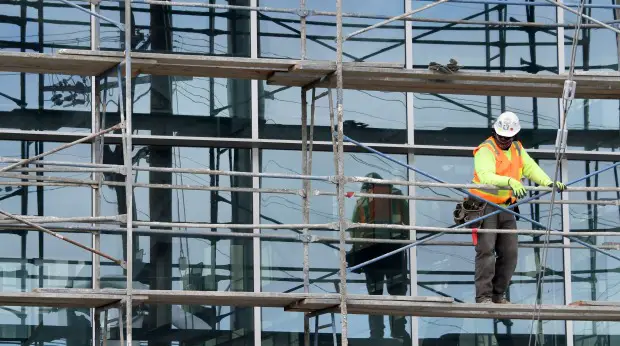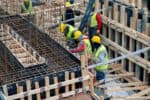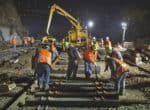Scaffolders should not work in rain considering the risk it possesses leading to instability and unreliability.
The reason for this is that when it rains, a scaffold can become exceedingly slippery and hazardous, resulting in a downfall, hence it should not be used concerning the employees’ safety. Building scaffolds possess the same risks as using a scaffold.
So, building and using scaffolding in adverse weather conditions, is potentially risky for everyone who works on it and can result in incidents that could have been prevented.
Before anyone is allowed to climb on the scaffold, the water, mud, and even debris left behind after a downpour in the construction site should be completely wiped from the platforms.
This article incorporates professionals’ knowledge to provide the reader with a comprehensive explanation of why scaffolders should avoid working in the rain, as well as the lighting and winds that come with it.

Reasons For Not to Let Them Work During Raining
As you know Scaffolding, also known as scaffold or staging, is a temporary structure used to assist a work crew to aid in the construction, maintenance and repair of buildings, bridges and all other man-made structures.
And scaffolders are a branch of construction workers who erect and dismantle these temporary structures, allowing other construction workers to work safely at height.
They begin by unloading the required equipment, which includes scaffolders unloading the correct type of scaffolding, the requisite number of poles, and the three basic elements standards, ledgers, and transforms.
The risk of their working in the rain stems from their next steps. The base plates must be set in the ground for the structure to be built, and a sturdy foundation is required.
During rain, however, the likelihood of the ground becoming muddy and swampy is too high, resulting in the ground’s evenness with the baseplate and soleplate collapsing.
If this occurs, it becomes a severe impediment to the structure’s subsequent development because firm foundations were not established in the first place.
Fixing the scaffold to the building structure and putting down planks at a height during rain is exceedingly dangerous and should be avoided at all costs as the project progresses.
The biggest reason to avoid scaffolding while it’s raining or windy is because the poles might be extremely slippery, causing you to lose your balance while working.
In addition, water droplets in the rain, along with dust in the building site, might distort your vision, causing you to make mistakes.
Fastening the scaffold into the building structure during rain is not recommended since both surfaces may be slippery, and fixing and connecting both at the same time may not end in perfection.
As a result, it could result in devastating mishaps for the scaffolders as well as the construction workers that use the scaffolding.

Scaffold and Rain
You can employ a variety of scaffolds on your project, but when the scaffold gets wet, it will nearly always become slippery.
Workers must exercise considerable caution when working on a wet scaffold, even in moderate rain.
Many scaffold systems employ a wooden board as the work platform, and depending on the wood, even a small amount of water on it can make the surface slippery.
If you have to work in the rain on a frequent basis, adding traction material to the board’s surface can help with stability.
Rain can result in:
-
-
- Wet metal surfaces and marshy ground.
- Wind-driven construction materials falling
- Unstable scaffold due to slippery
- Tougher and inhospitable working conditions
-
If it begins to rain heavily, or if your workers express worry about the circumstances on the scaffold, bring them down until the weather improves.
Most construction projects have tight schedules, yet an accident or death is not worth the risk of missing the deadline.
Therefore it is paramount to continuously mark all the wet surfaces, and preplan and prioritise procedures which must be in place to protect workers from slippery surfaces and falling objects. Anything from netting and toe boards to shrink wrapping and barriers could be used.
Down below are the other four scaffold hazards associated with raining.
See also: Do Construction Workers Work in the Rain?
The Four Scaffold Hazards During Rain
It is usually recommended that scaffold hazards be identified in order to work in a safe and secure environment and plan out the necessary safeguards.
1.) Wind Concerns: Working in windy weather is a valid cause to stop working, as there have been numerous reported occurrences of scaffolds overturning or collapsing in high-wind conditions while it is raining.
The site engineer should offer the parameters for evaluating high and low wind speeds that workers can work in without concern.
He should consider these criteria in determining whether it is safe to continue working, as well as explaining the requirements to employees and ensuring that they are strictly followed.
2.) Lightning Concerns: OSHA, the Occupational Health and Safety Administration, advises that all outside work be halted once the thunder is heard and storms are approaching.
This guideline specifically covers working on a scaffold and the increased risk posed by the metal structure and the platform’s height.
Because most scaffolds are made of steel or aluminium, they are more likely to be struck by lightning than other sections of the structure.
When using a wooden scaffold, keep in mind that the wood might become soaked with water and become just as dangerous.
3.) Less Sunlight Concerns: This can limit your eyesight, putting you at a greater risk of slipping and falling. For this reason, it’s critical that scaffolding sites are well-lit and that warning signs are visible during less sunlight and raining, including when it’s dark, to bring attention to hazards.
Also, when the light is low, wearing hi-vis jackets enables you to see the other crew members, and your scaffolding crew should make every effort to keep all items off of walking paths to avoid trip hazards.
4.) Wet Leaves Concerns: Scaffolding constructions are no exception to their slick nature, thus wet leaves left after a rainstorm could be particularly problematic, resulting in a near-fall head over heels on a wet leaf. As a result, ensure your surfaces are free of them and that the workers are safe.
Six Top Safety Tips When Using Scaffolding in The Rain
Working in the rain isn’t ideal, but it’s sometimes unavoidable. Rainy day work may be unavoidable if you’re renting scaffolding and need it dismantled by a certain date, or if your project has a tight deadline. However, never put worker safety or project quality in jeopardy to meet a deadline.
To be productive in the rain, follow these scaffolding safety guidelines:
1.) Stabilise The Scaffold: When it rains, the ground upon which the scaffolding has been placed is more likely to get weakened, especially if there has been significant precipitation.
As a result, the scaffolding structure’s feet will readily sink into the ground. To overcome this problem, you can use something sturdy and secure, such as blocks of wood, to support each foot of the scaffold. When the scaffold is damp, this also helps to keep it from sinking into the ground.
2.) Secure Tools and Materials: During rain and wind, remove the tools and materials from the walkways and store them somewhere safe. If the tools are found in the walkways, there is a good chance that a worker will trip and injure themselves.
3.) Climb With Caution: Climbing scaffolding should be done with caution, with one foot placed firmly on the ground at all times. Use handrails and guardrails at all times.
Keep an eye out for potentially slick surfaces, and only elevate your foot to climb if the other foot is secure. While climbing or descending, don’t overburden yourself with too many gears or supplies. Flip wood planks to a drier side if necessary.
4.) Turn The Planks When Necessary: Another precaution to take when using scaffold while it is raining is to turn the planks only when it is necessary. When it rains, planks become too slippery, therefore it’s advisable to turn them over.
However, attention should be exercised when flipping it because the shower can cause the plank to lose its grip. Though, if you hire a reputable scaffolding firm, you won’t have to worry about the performance and safety of the wooden planks.
5.) Pay More Attention to Workers’ PPE: All dangerous jobs necessitate the use of personal protection equipment. And, in particular, for work at a height.
When it comes to working in the rain, though, you need to pay special attention on how well your employees is equipped. To be obvious, moist surfaces increase the chance of slipping.
As a result, wearing non-skid footwear helps your employees avoid this danger. Their heads are protected by hard hats in the event that they lose their balance or have something fall on their heads.
If they slip, full-body harnesses keep them from falling down the scaffolds. Finally, waterproof jacket keeps the workers dry and prevent them from being ill.
6.) Inspect Scaffolding Afterward: Visually inspect the scaffolding for any vulnerabilities, such as dents or weak points, once the storm or rain has passed. Before continuing to use the scaffolding, make an appointment with a competent scaffolding inspection agency.
Conclusion
By now, you know the risk factors associated with building scaffold structures during the rain and what should be done to help one be productive working on the scaffold during rain.
You also come across the fact that no one should jeopardise the worker’s life concerning the risks it possesses regardless of how tight your schedule is.
The rain results in wet and slippery surfaces, especially the poles and planks, this is the sole reason why working on scaffolds during rain is not recommended by any professionals.
Also, it is always advised to have subject matter experts review the entire plan as well as the precaution methods you adopted.








